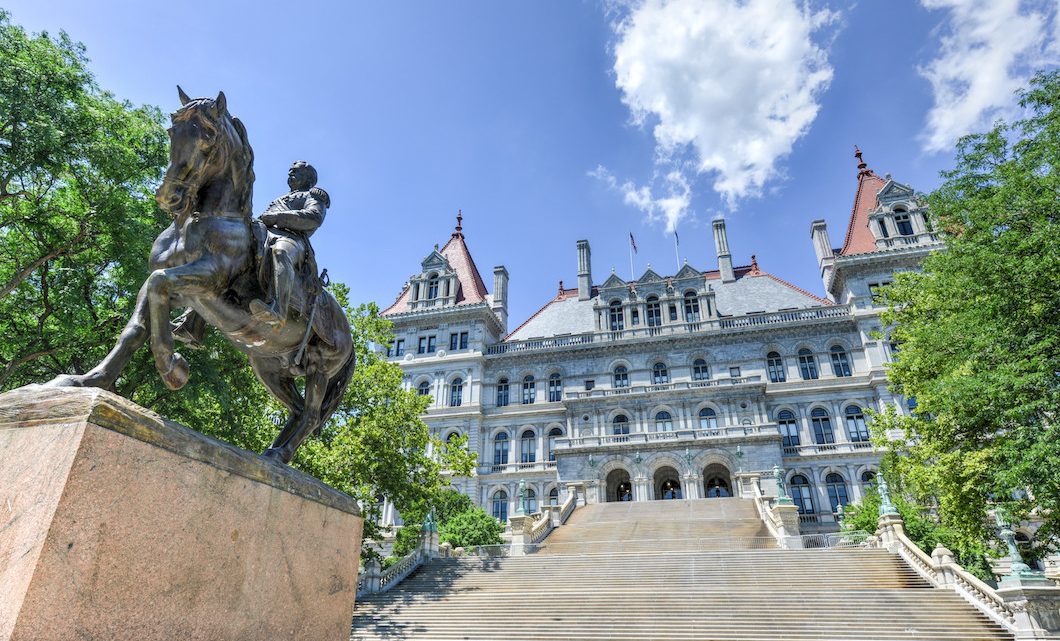
Albany Finally Has a Chance to Reform the Subways
November 8, 2018On April 27, 2019 the L train in New York City will shut down for 15 months between Manhattan and Brooklyn to repair damage caused during Hurricane Sandy. Leading up to the closure, VICE will be providing relevant updates and proposals, as well as profiles of community members and businesses along the affected route in a series we're calling Tunnel Vision. Read more about the project here.
At a talk with transit advocates in downtown Manhattan a month or two ago, an attendee asked a local elected official the question that often finds itself on the minds of New Yorkers: what can actually be done to fix the city’s subways? The official, a Democrat, replied with a piece of advice that could have been read then as self-promotional: “Flip the State Senate.”
And on Tuesday night, that’s what New Yorkers did.
For the first time in eight years — and the third time in the past 50 years — the New York State Senate went blue, handing the party full control of Albany with the easy re-election of Governor Andrew Cuomo to a third term. Traditionally a pocket of power for New York Republicans, the State Senate fell to a wave of heightened turnout and insurgent Democratic candidates, who dominated local races back in September’s primaries.
Come January, there will be a total of eight new Democratic senators in Albany, totaling 39 seats out of 63; in other words, a pretty solid majority. And with that, Senator Andrea Stewart-Cousins will become the first woman and first black woman to lead an entire chamber, upending the “three men in a room” ruling ethos that has codified New York politics (and its corruption) for as long as anyone can remember.
So for New York State Democrats, Tuesday was a really big deal. But it left me thinking back to that transit event. The Democrats got what they wanted: full control of Albany. So what does that mean for America’s largest public transit system?
But before diving deeper into this question, it’s worth offering a bit of context.
The ire of the New York transit advocacy community — at least in regards to mass transit woes — has largely fallen upon two parties in Albany: the Senate Republicans, and Governor Cuomo.
The Senate Republicans, who control districts largely outside of the city, have been criticized for not scrutinizing the Metropolitan Transportation Authority (MTA), and dead-ending sustained funding streams to plug up the billions of dollars the MTA is requesting in capital and maintenance fixes. (The Fast Forward Plan, which would modernize the city’s subways, could cost up to $30 billion.) That includes congestion pricing, which would charge private cars to enter Manhattan’s busiest areas at rush hour.
Meanwhile, Governor Cuomo, transit advocates argue, acts as if he hasn’t been the person responsible for the MTA over the last eight years, shifting blame to the city, the state Legislature, and history itself for the subways’ deterioration. Additionally, the governor has been hit by critics for spending too much on seemingly “big-ticket” items, rather than regular upkeep.
But now, that equation is totally flipped. The State Senate will be filled to the brim with Democrats who have said that mass transit reform is a top priority. And the Governor, who everyone thinks is eyeing 2020, has another term and a clear path for addressing a major political vulnerability of his, should he run for the White House. Already, there has been talk about what could be in store in 2019, from congestion pricing to stronger local control.
With that in mind, I reached out to Ben Kabak, the voice behind Second Avenue Sagas, a renowned transit blog in New York. What were his thoughts on the subway’s plight now, post-election?
“I’m optimistic that a Democratic-controlled body will be willing to exercise its oversight powers and focus on cost and spending issues that have resulted in the MTA’s costs being constantly out of line with international standards,” he said to me in an email. “By streamlining construction and reforming costs, the MTA could expand transit faster and cheaper than it does today.”
“This is a tall ask though and requires diligence from a State Senate that has been reluctant, at best, to wade into issues surrounding the MTA,” he continued.
Read: The L Train Shutdown Is Really Happening
But Kabak said he did “expect a fast resolution” on congestion pricing when lawmakers return to Albany in the new year, as it’s something that both Gov. Cuomo and the Senate Democrats have been publicly supportive of. (Even New York City Mayor Bill de Blasio, hesitant at first, appears to be coming around to it after Tuesday.)
“The State Senate has no excuses not to act now,” Kabak argued. “At the least, this will help clean up overcrowded Manhattan streets while guaranteeing a steady revenue stream for the MTA. It’s not a panacea, but it’s the first step in shoring up the agency’s shaky finances.”
When reached for comment, Aaron Gordon, a transit journalist who writes the widely read Signal Problems newsletter, said oversight must first be addressed by a Democrat-controlled Albany. “The State Senate has not held one hearing on the MTA since the subway crisis began, other than routine and non-inquisitive budgetary discussion,” Gordon told me.
But the pressure is also on lawmakers, Gordon explained, to balance out Cuomo’s capital (and perhaps even presidential) wants, vis-a-vis the MTA’s more mundane day-to-day needs. “Cuomo has made it clear he wants to be perceived as a builder, which is in fundamental tension not just with the subway’s more urgent needs, but the MTA’s overall financial situation,” he explained.
“Does the fresh blood in Albany and overwhelming Democratic control mean things will be different this year? Or does Albany just throw money at the problem, allowing Cuomo to continue building the projects he personally wants most?” he continued. “How this gets addressed and resolved, if at all, will be the ongoing tension of the coming years.”
Congestion pricing, Gordon added, will likely capture the immediate attention of lawmakers, and the public. But, he said, he doesn’t think “it’s super important for fixing the subway” — “I think it’s important for reducing traffic in Manhattan.” (Which, as VICE has reported, is god awful.)
To find out where Albany stood on all of this, I decided to give that local elected official from earlier a call the day after the elections — especially since it was my own state senator, Michael Gianaris. “The reality is a Senate majority that is going to prioritize MTA funding,” the senator told me. “And at least have people who care about finding a solution.”
Sitting on the MTA Sustainability Task Force, Sen. Gianaris said the group plans to release a slate of recommendations by the end of this year, which will include congestion pricing. He added that the funding mechanism wasn’t the only solution being mulled; it has been reported that the scheme wouldn’t garner every dollar of what the MTA will need. “But we have to find money somewhere,” he said.
Previously, Sen. Gianaris, who is second-in-command of his party’s conference, had proposed a “millionaire’s tax” on New York’s highest earners to pay for mass transit fixes, which Mayor de Blasio later supported. (The mayor pushed the measure again on Wednesday, calling it the “most politically viable” solution.) The “millionaire’s tax,” Sen. Gianaris said, will also be weighed in coming discussions.
When asked about Gov. Cuomo’s role in the discussions, Sen. Gianaris told me that the governor has “been a clear supporter” of congestion pricing, and other reforms. And while the current leaders of the MTA are said to be cutting costs, he said, overhauling how the authority actually spends its money — which Gianaris has criticized before, specifically in my own district — is also a priority of the new State Senate, he said.
“Everything’s on the table.”
Sign up for our newsletter to get the best of VICE delivered to your inbox daily.
Follow John Surico on Twitter.


